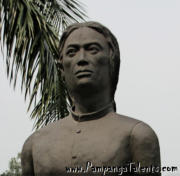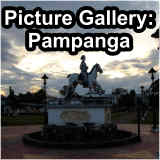

Heroes in Pampanga: Francisco Maniago
Francisco Maniago and its revolt (Ca. 1660) “pag
aalsa ni maniago”
1660 The “Pampangos”*, as the hardest and “the most warlike and prominent people of these Island”*, raised their will against the Spaniards. The Pampangos - Trained in the “Military art”* by the Spaniards themselves. From the perspective of the Spanish crown domination: “3 Pampangos and 1 Spaniard was equal to 4 Spaniards”* and saw the “loyal population”* of Pampanga as honoured by the introduction of the Christian faith and infrastructure. But the population was punished for the "alleged prosperity"* with hard forced labour. The first treatment of the resistance fighter: The Pampangos resistance burns down their own accommodation because of the unfair treatment by the wood-cutting “Overseers”*. Don Francisco Maniago, a native “master of the camp for its Majesty”* from Mexico Pampanga becomes the leader of this revolt. After the Pampangos (under leadership of Don Francisco Maniago) send out compounding letters to other provinces as well the closing the rivers mouths in Bacolor (in order to stop the commerce with Manila), the Spaniards have to solve this internal problem quick (internal problem in the view of the colonial rulers). A bust of Francisco Maniago is part of the Heroes Gallery in Luneta Park (Rizal Park) Manila. Woodcutting under high pressure - related topics: 1) 1640 to 1648 the 80 years’ war between the Dutch’s and Spain comes to an end and the Dutch’s gets there liberty. Example: In Dec. 1600 the San Diego, a Spanish trade galleon has been engulfed in Philippine waters by the Dutch’s. 2) Anglo-Spanish War (1654–60) a conflict between the English Protectorate and Spain. A commercial and colonial war. 1657 - England goes into a alliance with France. 2) Sabiniano Manrique de Lara the Spanish Governor-General of the Philippines orders on May 6, 1662 the evacuation of ford San José Fort in Zamboanga for their Manila defense against threat of Chinese invasion by Koxinga, a Chinese pirate. Add. Keyword: Malong Revolt (1660-1661) * Quote source: “The Philippine Islands 1493-1898 Volume 38”


Heroes in Pampanga: Francisco Maniago
Francisco Maniago and its revolt (Ca. 1660) “pag aalsa ni
maniago”
1660 The “Pampangos”*, as the hardest and “the most warlike and prominent people of these Island”*, raised their will against the Spaniards. The Pampangos - Trained in the “Military art”* by the Spaniards themselves. From the perspective of the Spanish crown domination: “3 Pampangos and 1 Spaniard was equal to 4 Spaniards”* and saw the “loyal population”* of Pampanga as honoured by the introduction of the Christian faith and infrastructure. But the population was punished for the "alleged prosperity"* with hard forced labour. The first treatment of the resistance fighter: The Pampangos resistance burns down their own accommodation because of the unfair treatment by the wood-cutting “Overseers”*. Don Francisco Maniago, a native “master of the camp for its Majesty”* from Mexico Pampanga becomes the leader of this revolt. After the Pampangos (under leadership of Don Francisco Maniago) send out compounding letters to other provinces as well the closing the rivers mouths in Bacolor (in order to stop the commerce with Manila), the Spaniards have to solve this internal problem quick (internal problem in the view of the colonial rulers). A bust of Francisco Maniago is part of the Heroes Gallery in Luneta Park (Rizal Park) Manila. Woodcutting under high pressure - related topics: 1) 1640 to 1648 the 80 years’ war between the Dutch’s and Spain comes to an end and the Dutch’s gets there liberty. Example: In Dec. 1600 the San Diego, a Spanish trade galleon has been engulfed in Philippine waters by the Dutch’s. 2) Anglo-Spanish War (1654–60) a conflict between the English Protectorate and Spain. A commercial and colonial war. 1657 - England goes into a alliance with France. 2) Sabiniano Manrique de Lara the Spanish Governor-General of the Philippines orders on May 6, 1662 the evacuation of ford San José Fort in Zamboanga for their Manila defense against threat of Chinese invasion by Koxinga, a Chinese pirate. Add. Keyword: Malong Revolt (1660-1661) * Quote source: “The Philippine Islands 1493-1898 Volume 38”
























































